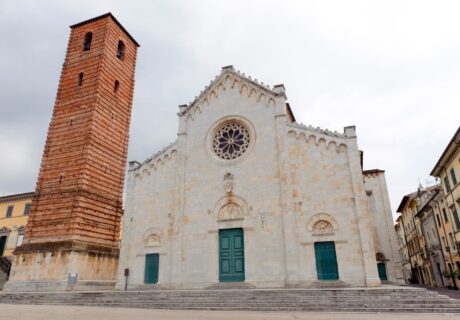5 villages in the Apuan Alps to visit
5 min · 9 Oct 2024

Situated in the north-west of Tuscany, where the region borders on Liguria, the Apuan Alps are not only one of the most beautiful and interesting natural settings in Italy. The landscape is also dotted with characteristic villages that are definitely worth a visit. Here we have selected five that are the perfect destination for a trip out of town. Let’s discover them together!
Gallicano
Located at the foot of Mount Pania, in the southernmost part of Garfagnana, Gallicano is a charming village that preserves the remains of its medieval past. Its origins are still shrouded in mystery. It appears for the first time in a document dated 770, in which the purchase of a house by a bishop from Lucca is mentioned. The village grew up around the castle built in the 11th century, which after 1370 became a perfect example of a medieval fortress that can still be appreciated today. The oldest part of the village is gathered around the Pieve di San Jacopo. Built within the castle walls in the 15th century to replace the old parish church, it houses a valuable glazed terracotta altarpiece attributed to Andrea Della Robbia. Other sights include the Church of San Giovanni Battista, the Church of Santa Maria and the Church of Sant’Andrea.
Fabbriche di Vallico
A hamlet of the scattered municipality of Fabbriche di Vergemoli, Fabbriche di Vallico is a delightful Garfagnana village rich in cultural and spiritual nuances that intertwine in a mosaic of testimonies and monuments. The village was founded in the 14th century by blacksmiths from Bergamo who settled here to work Apuan minerals (some historical ironworks remain of their presence). In the heart of the village stands the Church of San Jacopo, erected on the site of an old hermitage built in the early 13th century and closed in the mid-16th century. Inside is a reproduction of the Grotto of Lourdes. But the village’s most famous monument is the Colandi Bridge, commonly known as Ponte della Dogana. Located on what were the borders between the Duchy of Modena and the Republic of Lucca, it has a typical ‘humpback’ structure, which gives its architecture a unique charm.
Pescaglia
Situated in the southern Apuan Alps, Pescaglia is a charming village made up of several hamlets. It was founded in the 11th century by the Soffredinghi family, of Lombard origin, who dominated it until 1272, when it became part of the possessions of the city of Lucca. The territory has always been closely linked to the rural world, and this is well illustrated by the Chestnut Museum in Colognora, which documents the importance this tree has had from an economic and alimentary point of view; and the 17th-century Menicone mill, which preserves the ancient structures that are still functioning. Although Pescaglia is small, a large number of churches have been built here over time, including the Pieve di San Giovanni Battista in Monsagrati and the Church of San Martino in Freddana. Other sights to see include: the Puccini Museum in Celle, set up in the house where the composer spent his summer holidays as a young man; and the Vetriano Theatre, the smallest historic public theatre in the world.
Isola Santa
Absolutely not to be missed is the village of Isola Santa (a hamlet of the municipality of Careggine), an enchanted place that seems straight out of a fairy tale. It is located in the heart of the Apuan Alps and its foundations can be traced back to medieval times, when there was a hospitale in the village that welcomed the numerous wayfarers passing between Versilia and Garfagnana. Surrounded by nature, it consists of a few stone houses with slate roofs and a delightful little church, built at the behest of Countess Matilda of Canossa and now deconsecrated, overlooking an artificial lake (navigable by canoe, kayak or other craft) fed by the waters of the Turrite Secca stream.
Colonnata
Finally, the last village we recommend you visit is Colonnata (a hamlet of the municipality of Carrara). Set among the imposing Carrara marble quarries, it is known not only for its precious marble (the so-called white gold, extracted since Roman times) but also for the production of lard, once a poor food that has become a delicacy today. The precious stone is used to make artistic, structural and everyday works scattered throughout the village, such as the beautiful monument-tribute to the quarryman by the artist Alberto Sparapani that stands in the churchyard of the Church of San Bartolomeo. Inside the church, dating back to the 16th century, the main altar in white marble, the side altars in polychrome marble and the marble relief depicting the Assumption of Mary into Heaven among the Saints stand out.








